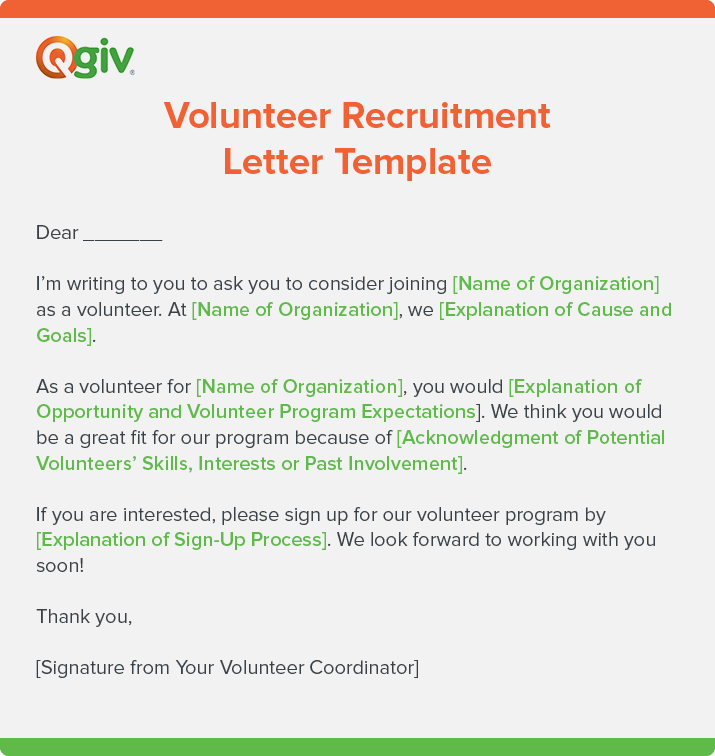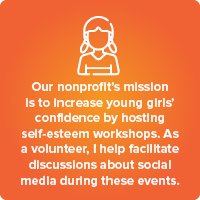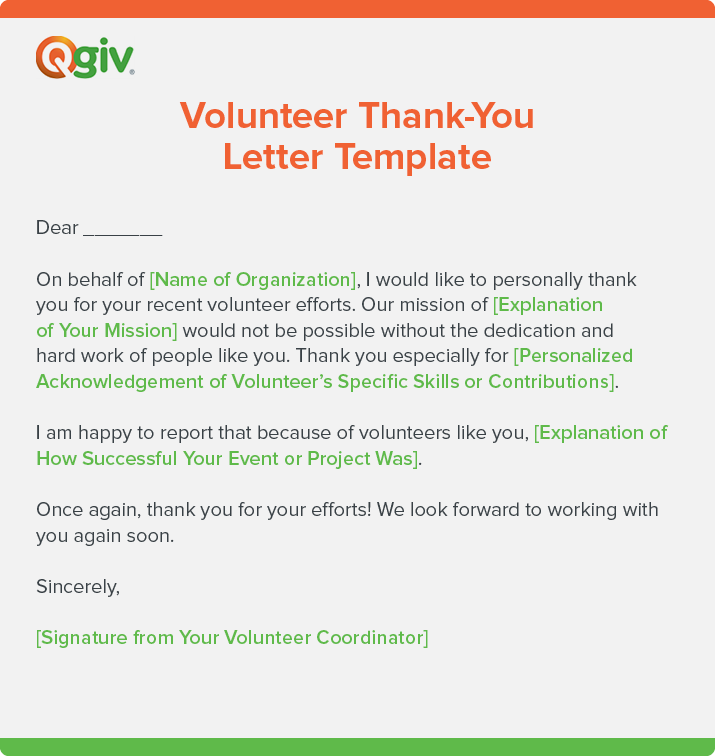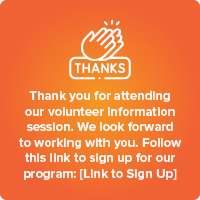Volunteers are the backbone of any nonprofit organization. They take care of your facility, give tours of your museum, welcome attendees to your annual gala, and pass out medals at fundraising races. They walk dogs at your animal shelter, ask for donations on your behalf, and spend their Saturday afternoons tutoring students. Clearly, volunteers are essential to your nonprofit’s ability to move its mission forward.
But volunteers don’t just appear out of thin air. Your organization needs a solid plan for finding and holding onto dedicated volunteers. That’s where volunteer recruitment comes in.
In this guide, we’ll introduce you to volunteer recruitment and its importance. Then we’ll give you the strategies you need to find volunteers who can truly make a difference to your organization’s work.
Here’s what we’ll cover:
- Why are volunteers important to nonprofit organizations?
- What is volunteer recruitment?
- Volunteer Recruitment: 15+ Strategies
As you implement the strategies given in this guide, you’ll be able to find and recruit people who want to dedicate their time and talent to helping your organization.

Why are volunteers important to nonprofit organizations?
It’s no secret that nonprofits rely on volunteer work. But do you know the value that volunteers bring to your organization? Let’s look at some reasons why volunteers are so essential to nonprofits:
- Volunteers help nonprofits reduce operating costs. According to an Independent Sector study, volunteers are worth over $28 an hour on average. This shows just how much value volunteers bring to the table. When someone is willing to donate an hour of their time, a nonprofit is able to save money while getting the assistance they need to move their work forward.
- Volunteers help nonprofits connect with the community. There are likely a number of interested parties in your community that want to make the world a better place. By hosting a volunteer program, your organization can enable students, city officials, business owners, and other community members to get involved with a cause that aligns with their values and helps people in need, strengthening community ties in your area.
- Volunteers help nonprofits expand their donor networks. People are often more comfortable getting involved with an organization if someone they know is already involved with that organization. This means that volunteers can help you find new donors (and other volunteers) as they spread the word about your work to their family, friends, and professional connections. Also, don’t underestimate the donating power of volunteers themselves. Volunteers are 66% more likely to make financial contributions to the organization they support than those who do not volunteer.
Volunteers are important to nonprofits for a range of reasons like these. However, to know the true value of volunteers to your unique organization, you should work with your team to identify how they’ve helped your nonprofit power its programs and services in the past. This can help you learn how best to recruit more volunteers.

What is volunteer recruitment?
Volunteer recruitment is the process of attracting and recruiting volunteers to your organization whose values align with your nonprofit’s values. These volunteers should have the time, skills, and interests to help you provide programming and services to your beneficiaries.
Though they go hand in hand, volunteer recruitment shouldn’t be confused with volunteer retention. Retention is everything your organization does to keep the volunteers you recruit, like providing proper training and management, aligning volunteer assignments with individual volunteers’ interests, or working hard to create personal relationships with your volunteers.
To have volunteers to retain, you first have to optimize your volunteer recruitment process. Let’s dive into some strategies for doing so!

Volunteer Recruitment: 15+ Strategies
In order to recruit the best volunteers, you’ll need to freshen up your strategies for attracting them to your program and encouraging them to sign up. Here are 15+ strategies to get you started.

1. Identify your organization’s volunteering needs.
Volunteer recruitment won’t do your nonprofit any good if you don’t have a clear plan for what those volunteers will be doing for your organization. Take the time to assess your operations and evaluate any gaps that volunteer work could fill. Here are a few tasks you might want to turn over to volunteers or recruit more volunteers for:
- Day-to-day office work or cleaning
- Door greeter roles
- Docent positions
- Event committee positions
- Event registration and ticketing
- Event set-up and clean-up
- In-kind donations collection
- Marketing and promotion tasks
- Fundraising tasks
- Teaching or tutoring
Once you’ve pinpointed what you need new volunteers to do, write out “job descriptions” for different volunteer roles to put on your volunteer website. This will help prospective volunteers find opportunities they’re most interested in or best equipped for.
Another thing to take into consideration is the demographic and situation you’re trying to find volunteers for. For example, if you’re hosting a peer-to-peer fundraising event on a college campus, having college-aged volunteers will help you better connect with your target audience.
Also, take the size of your event or volunteering task into account. This will influence how many volunteers you’ll need to recruit and train. For example, you’ll need far fewer volunteers at a small lecture event than you will at a community-wide dance-a-thon.

2. Use current volunteers as a resource.
Your current dedicated volunteers can serve as ambassadors for your volunteer program. After all, people are much more likely to engage with an organization if someone they know and trust is already involved. Here are some ways to mobilize your volunteers to help you recruit:
- Ask volunteers for referrals. Happy volunteers should be able to suggest at least one person from their personal or professional networks who you can reach out to about volunteering for your organization. You could even ask volunteers to facilitate a warm introduction for you instead of just giving you a list of names. A coffee meet-up is perfect for this type of introduction.
- Have volunteers email or pass out volunteer recruitment letters. A volunteer recruitment letter is a more formal way of soliciting volunteers, but you can have your current volunteers personalize them for the prospects they have in mind. Try using the following template to create your own recruitment letter:
- Make sure current volunteers are prepared to explain your organization’s mission and why they’re involved in your volunteer program. Your volunteers should be able to clearly articulate what your organization stands for and what makes it worth volunteering for. Try giving your volunteers “elevator pitches” they can use when encouraging others to join your volunteer program. Here are some templates you can use to base you own elevator pitches off of:
Asking your volunteers to help you in your volunteer recruitment efforts can also provide valuable insight into your current volunteers’ experience. If none of your volunteers want to help recruit or give a name of a friend or family member who could volunteer for you, you may want to step back and survey your volunteers to gauge their current satisfaction and engagement levels.

3. Reach out to former volunteers.
In addition to turning to your current volunteers, you should also use former volunteers as a resource. After all, even if they no longer volunteer with your organization, there was a time when they were actively engaging with your work. They may want to engage again now or they may be able to provide valuable insight into potential improvements you could make in your program. There are three things you may encounter when reaching out to former volunteers:
- The volunteer needed a break. If this is the case, a thoughtful follow-up could be just the thing to get them involved again. Make sure to personalize this follow-up. To go the extra mile, include a personal message from a staff member or another volunteer whom the person worked with previously.
- There were issues with a previous volunteer program that caused the volunteer to leave. View this response as an opportunity. Learn about the challenges that faced your volunteer program then and identify if there are improvements that you could make now. Once you’ve implemented improvements, highlight how your new program is different and invite the volunteer to engage again.
- The volunteer quit due to COVID-19 concerns. Explain your current COVID-19 safety protocol (social distancing, hand sanitizer stations around your facility, etc.) and introduce the former volunteer to any new virtual volunteer opportunities that are available.
As you talk to former volunteers, they may not have the time in their work or family schedule to engage again with your nonprofit. However, they may be willing to be a resource for prospective volunteers to ask questions and help them gauge whether volunteering with your organization is right for them.

4. Ask your board to get involved.
Your nonprofit’s board members are responsible for a number of tasks. One of those is ensuring your organization has the resources (like volunteers!) to continue moving its mission forward.
Ask your board members for volunteer recommendations. They likely know family, friends, or colleagues who are looking for opportunities to give back to the community. Additionally, board members often have high-level connections in business, education, or even local and state government. They could help you coordinate a corporate volunteering day or connect you with a local club that is seeking a volunteering opportunity.
If you’re looking for a way to further engage your board members, don’t hesitate to ask them to volunteer in new ways. This can be a great way for them to get to know your staff and interact with donors during your next event or project.

5. Collaborate with local businesses.
Local businesses are often looking for ways to give back to the community. Many employers feel this not only helps their employees align their values with larger organizational values but also helps improve their organization’s standing and reputation in the community. Here are a few ways to get local businesses involved in your volunteer program:
- Reach out to volunteer coordinators. Some larger corporations have volunteer coordinators. A volunteer coordinator’s job is to manage the company’s charitable presence in the community. This means they can be a great resource for helping you find a large number of volunteers quickly or to set up regular corporate volunteering days.
- Identify companies who offer VTO. Volunteer time off is a type of paid leave that employees can use to volunteer for approved nonprofits or other charitable organizations. VTO can help incentivize people to donate their time to your organization, so try reaching out to companies who offer VTO to promote your volunteer program.
- Use corporate sponsorships to their full potential. A corporate sponsorship usually involves a sponsor supporting an event, donating auction items, or giving a monetary gift to help you meet a fundraising goal. But why not ask your corporate sponsors to introduce you to potential volunteers or volunteer themselves?
- Coordinate with HR departments to connect with retirees. Often retirees look for volunteering opportunities to fill their new free time. Try reaching out to HR departments at local organizations to find current or soon-to-be retirees who may be interested in joining your program. They can provide valuable insight and perspective, and often have more flexible schedules than younger volunteers.
- Publicize volunteer grant opportunities. Through volunteer grant programs, companies provide grants to organizations where employees volunteer on a regular basis. Incentivize potential volunteers to get involved with your nonprofit on a regular basis by educating them about volunteer grant opportunities. Here’s how a volunteer can help you secure a grant for your organization:
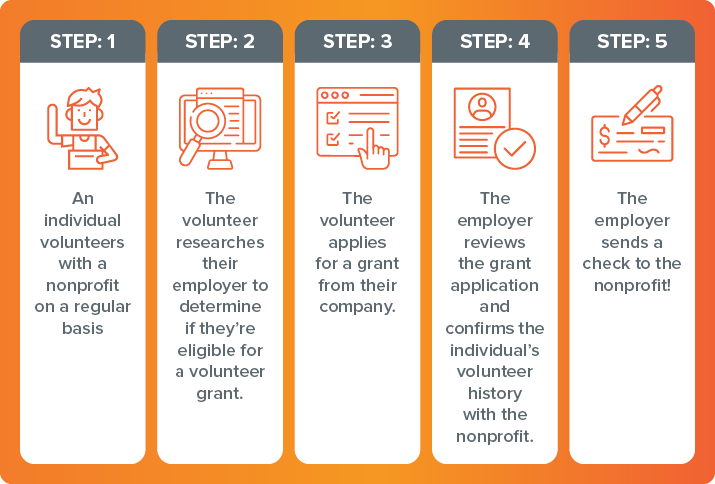
Local businesses and organizations within your community can be your allies as you work to recruit more volunteers. Try catering your volunteer opportunities to your community partners’ interests so they’re extra excited to get involved.

6. Get sponsors involved in event committees.
As mentioned in the previous section, sponsors can help your organization in a number of ways. One way you can encourage them to do so is to invite them to work on event committees.
A position on an event committee can keep your sponsor happy with their decision to work with you, as they’ll feel they are truly involved and can make their voice heard as you work together to do good in the community. Sponsors who are involved like this are more likely to mobilize their employees to volunteer for your event. Additionally, some organizations, like Wal-Mart, award grants to nonprofits based on how many staff help on the day of an event or how many collective service hours they log.
Try getting creative with the sponsorship levels or packages you offer. You could, for example, offer additional amenities for sponsors who fill an event committee role or provide event volunteers.

7. Connect with civic groups.
There are likely a number of civic groups in your local area that would be interested in your volunteer program if they knew about it. To find these groups, you’ll need to get out in the community and start talking about your cause. Try the following:
- Attending networking events. Try not to attend events like these alone the first time you go. See if a well-connected board member or current volunteer can go with you to facilitate introductions to key community members.
- Joining local civic groups like your local Kiwanis or Rotary Club. Groups like these are constantly looking for volunteering opportunities for their members. Get on their radar and show them you’re interested in their work by joining their organization. Then they’ll feel encouraged to work with your organization!
- Looking for local groups that invite guest speakers. Offer to speak to the group’s members about your mission and your impact. Some groups who may have cancelled in-person events due to COVID-19 may be back to hosting in-person guest lectures, while others have resumed events online. Either way, prioritize the groups who are the most active and be sure to encourage them to get involved in your volunteer program at the end of your speech.
- Reaching out to local churches. Local church leaders are often looking for service opportunities for their youth groups and ministries. Connect with local religious leaders and find out what sort of opportunities their congregation is most interested in and to share information about your program.
- Going outside of the box. Consider what other types of organizations might be interested in helping you find volunteers. For example, an organization seeking to support those with cancer might see if local cancer care clinics are willing to post flyers advertising your program. In a situation like this, you can find passionate volunteers and those who need your organization’s services at the same time.
Civic groups are a wonderful resource for recruiting volunteers because they’re sincerely invested in making your community a better place. Plus, they know the challenges facing your community and can help you connect with others to solve problems and spread your mission in your local area.

8. Host info sessions for potential volunteers.
It may be the case that people are interested in your volunteer program but want to learn more before signing up. Try hosting an info session, either virtually or in-person, to explain your program and answer any questions you might have. Here’s what you should cover:
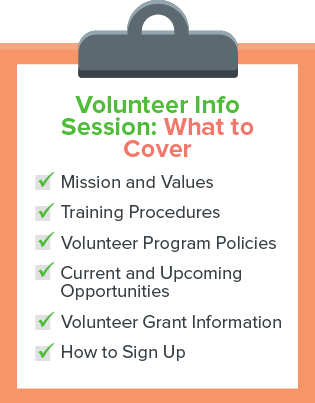
- Your organization’s mission and values
- Training procedures
- Program policies
- Current and upcoming opportunities (both in-person and remote)
- Information on volunteer grants
- How to sign up
It’s also a good idea to ask a current volunteer to attend the info session to provide their perspective on your program. Leave time for questions at the end of the session. You could also make it extra fun by giving away free branded swag to all who attend!

9. Recruit through professional organizations.
It’s true that some people don’t want to spend their volunteer hours doing what they do professionally. However, some people do. For example, if teaching is your profession, you might feel most comfortable and fulfilled when spending your volunteering time tutoring young students. Or, if you’re a certified public accountant, you might be willing to lend your services to a nonprofit during tax season.
To find professionals who are interested in sharing their time and skills with your organization, reach out to local chapters of professional organizations like the National Association of Realtors or the National Association of Female Executives. This is a great way to find volunteers with skills that can benefit your organization in a variety of ways.

10. Send out social media blasts.
Social media is a great place for making connections, especially when it comes to finding new volunteers. Here are a few tips for getting your volunteering opportunities seen and shared:
- Post about your volunteer opportunities consistently. If you want your social media followers to know about your volunteer opportunities, you need to talk about them. Do so frequently. Try sharing blog posts about a recent volunteer opportunity, sharing photos of your volunteers, or giving star volunteers a social media shout out. This will communicate to your followers that you value volunteers and want more people to get involved in your program.
- Use LinkedIn to see if you have professional connections with potential volunteers. Sometimes cold introductions don’t work as well when you’re recruiting volunteers. Use LinkedIn to see if you have any connections with potential volunteers, and then ask those connections to introduce you.
- Invest in paid social ads. Paid ads on platforms like Facebook or Instagram can ensure potential volunteers see that you’re looking for more people to sign up for your program. Though these ads require some investment up front, it will pay off in the end as more and more people sign up for your program.
There are also more informal ways to get information about your volunteer opportunities on social media. Try direct messaging a donor on Facebook and asking them to volunteer. You could even comment on your followers’ posts with a link to your sign-up sheet and an invitation to get involved.

11. Partner with local media.
Get the word out about your volunteer program by working with the local media in your area. There are a number of media outlets you can use to publicize your program, including:
- TV or radio stations
- Newspapers
- Magazines
- Local bloggers or social media influencers
No matter what outlet you think might suit your target audience best, here are two tips that can help you work with the media to recruit volunteers:
- Pitch a story. Newspapers, magazines, and blogs focus on storytelling. Frame your need for volunteers as a story that reporters or bloggers can tell and share with their audiences. For example, you might share the history of your organization and your annual gala with a local newspaper reporter, explaining that you need two dozen more volunteers for the event this year. The reporter can then tell the story of your organization and publicize your need for volunteers, helping them meet a deadline and helping you get the volunteers you need.
- Look into paid ad placements in newspapers and magazines. Many of these outlets offer remnant space for charitable organizations and endeavors at a very reduced cost or sometimes even for free. Don’t be afraid to think out of the box, either. Radio stations or sites like Autotrader (one of the biggest car-shopping sites in the world) have similar offerings for nonprofits.
When you work with local media, make sure your messaging and branding are consistent, whether your story or advertisement appears in print, via video, or on the local radio station.

12. Invest in paid online advertising.
In some cases, it may be wise for your organization to publicize your volunteer program through paid advertisements on platforms such as Google AdWords, Facebook, or LinkedIn.
Many organizations choose a pay-per-click (PPC) option, which means you only pay for your ad when people click on it. This type of ad relies on keywords, which means you’ll need to be intentional about choosing the right keywords for your volunteer opportunity or program. Choose a keyword that is specific to your organization or event so you don’t have to compete with other organizations for a high-volume keyword.
If you decide to go with Google Ads, consider applying for the Google Ad Grants program. This provides $10,000 per month in Google Ads to charitable organizations, helping them to promote their missions and programming to a wider audience than would normally be possible.

13. Network with city officials.
City officials like city council members or the city manager can be excellent resources for helping you with volunteer recruitment. This is because they’re often intimately familiar with the challenges facing your community and can help you identify civic groups or local businesses who may be interested in helping you out with your upcoming projects.
Ask your board members to introduce you to any city officials they might be connected to. From there, city officials can help you network with potential volunteers, as well as potential donors and sponsors.

14. Create a dedicated volunteer page on your website.
Much of your nonprofit’s website is likely geared toward the needs and interests of your donors. But what about your volunteers? We suggest you create a dedicated volunteer page on your website. On it, you can house the following resources:
- A volunteer program calendar and list of current volunteer needs (along with corresponding “job descriptions”)
- A sign-up form for your program
- Virtual training resources
- A password-protected volunteer portal for shift sign up
- Volunteer program announcements such as volunteer shout outs, volunteers of the month, or COVID-19 guideline updates
- Volunteer coordinator contact information
- Links to your donation form for volunteers who want to involve themselves further
Make sure you use your organization’s branding and well-crafted multimedia elements like introduction videos to make your volunteer page feel connected to the rest of your website and your mission. Check out how Lakeland Volunteers in Medicine made their page reflect their mission and their appreciation for their volunteers:


15. Tap into schools.
Students make great volunteers! They’re enthusiastic, eager to learn, and excited to help. Here’s how to recruit students in your community at different education levels:
- The college level: Partner with local colleges to offer internships students can participate in for college credit. You can also reach out to volunteering or civic-oriented clubs and organizations, like fraternities and sororities, to recruit new volunteers.
- The high school/junior high school level: Some high schools (usually private institutions) require volunteer hours to graduate. Additionally, some scholarship programs require volunteer hours, like Florida’s Bright Futures program. Connect with school guidance counselors to identify students who want and need to complete a certain number of volunteer hours and ask them to get involved with your organization.
- The elementary school level: Younger children love to help out just as much as older children do. Reach out to elementary school administrators and teachers to get their students involved in volunteering opportunities like crocheting winter hats for the homeless or decorating thank-you cards for military veterans.
When a local student begins volunteering with your organization, focus on making their experience the best it can be. This can go a long way in making a strong impression for your organization that will result in more volunteering and even monetary contributions down the road.

16. Have a succession plan in place for each volunteer position.
Volunteers choose to leave your organization for a variety of reasons, but the reality is that no matter the reason, a volunteer lost results in a hole in your program. When you lose a volunteer, you have to train a new volunteer to fill their place or take on the former volunteer’s duties. This can cost your organization time and money that could be spent elsewhere, which is why it’s important to have a succession plan in place for each volunteer position.
A succession plan is essentially a guide to what a volunteer should do if they can no longer fulfill their duties and need to pass them to someone else. You should make current committee chairs, for example, responsible for finding their co-chairs, naming potential replacement chairs, and bringing them up to speed on their duties before they leave your program.
Here is an example of what a succession plan might look like:
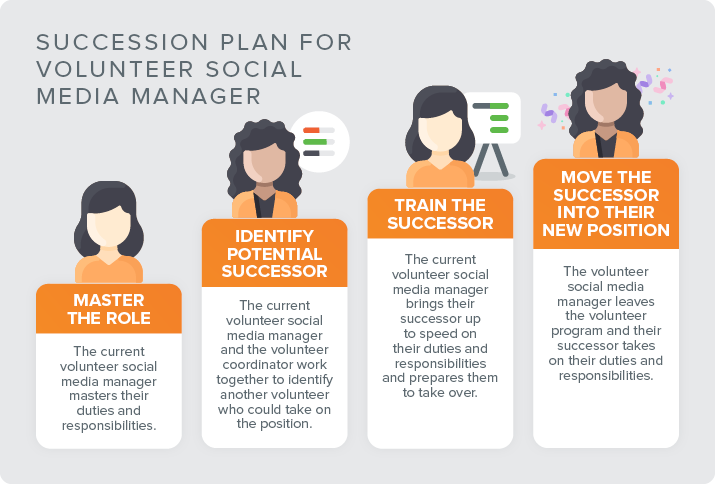
A succession plan like this can help you seamlessly transition volunteers into different roles, ensuring you don’t have to pause to train and reorganize your volunteer team.

17. Use volunteer matching sites.
A volunteer matching website helps connect your organization with people seeking volunteering opportunities. The real benefit of using a website like this is that you already know the website’s users value volunteering, so you won’t need to convince them that donating their time and skills is important. Your job will instead involve finding the right volunteers who connect with your mission and want to engage with your specific organization.
There are dozens of volunteer matching sites your organization can use. Here are a few we recommend:
Websites like these will typically help volunteers find opportunities in their local communities and will help you recruit by facilitating interviews with potential volunteers or collecting their applications. When posting opportunities on a volunteer matching site, include information about the duration of each opportunity and the skills required so you can find the best fit.

18. Have a thank-you plan ready from the start.
People want to volunteer with organizations that truly value their contributions. After all, volunteering often requires a sacrifice of time, especially if someone is volunteering on a regular basis.
Develop a good reputation for your volunteer program by emphasizing appreciation from the get-go. Make a plan to thank each person who attends an info session about your program or comes to a one-off volunteer opportunity.
There are a number of ways to do this, but handwritten notes, emails, and texts tend to yield the greatest results. Let’s take a closer look at each:
- Letters or emails. Letters and emails require a more personal touch from your organization, meaning you’ll typically use this kind of thank you for a volunteer who has been with your organization for a long time or a major donor who steps into a volunteer position for an event or campaign. Keep the letter or email personal and sincere and acknowledge the impact your volunteer has had. To get a boost on writing a thank you like this, use the template below.
- Texts. Thank-you texts are obviously shorter than thank-you letters and emails, but still require planning ahead of time. Use a thank-you text when someone attends a volunteer info session or signs up for your volunteer program. Keep the text short and professional, and make sure to encourage further engagement. Here are some examples of professional texts to inspire your planning:
When your volunteers feel seen and valued by your organization, you’ll have an easier time recruiting new volunteers (and retaining them). People will want to volunteer for your organization because they’ll see that you recognize their efforts to make a difference.

19. Optimize your current volunteers’ experience.
While volunteer recruitment is essential to building your program, it’s most ideal to retain current volunteers instead of constantly having to find new ones, which is an expensive and time-consuming process. The reality is that in order to successfully recruit new volunteers, you need to pay attention to your current volunteers’ experience with your organization. Here are a few ways you can optimize your current volunteers’ experience:
- Make sure existing volunteers are in the right role. Matching volunteers to the right roles for their skills, interests, and schedule requirements not only keeps current volunteers happy. It also helps you ensure you’re recruiting for the right roles instead of doubling up on talent you may already have at your disposal.
- Be sensitive to pandemic burnout. COVID-19 hasn’t been an easy thing to live through for anyone, and that includes your volunteers. Think about what you can do for your volunteers to help them combat pandemic fatigue, such as hosting a volunteer luncheon to thank them for their work or giving out movie tickets for a fun evening out on the town.
- Set expectations about flexibility. The COVID-19 pandemic has taught your organization to be flexible, and it’s important to communicate that need for flexibility to your volunteers as well. For example, you may have to quickly pivot to hosting your Giving Tuesday gala virtually instead of in-person. This might mean your volunteers need to be prepared to greet people via the chat on a livestream instead of at the door. Keep your volunteers in the loop and ensure they know Plan B for all of your big events and campaigns.
- Focus on relationship building. Building relationships is one of the most important aspects of volunteer management. Make an effort to get to know your volunteers as people. Remember birthdays, if they have a partner and/or children, and ask them about their hobbies. This will help your volunteers know that you care about them.
Seek feedback from your current volunteers and work to optimize their experience with your program. This will strengthen your brand as an organization that accepts volunteers and will help you both recruit and retain great volunteers for the long term.
Final Thoughts
The golden rule of volunteer recruitment is, “If you don’t ask, the answer is always no.” Use these strategies to help ask potential volunteers to get involved with your cause. As you build relationships with them and match them to projects based on their skills and interests, you’ll be on the road to creating a more robust volunteer program for your organization and retaining great volunteers.
For more information about optimizing your current and future volunteers’ experience with your organization, check out these additional resources:
- 8 Dos and Don’ts for Working with Volunteers. Read this article to learn how you can improve your approach to working alongside your volunteers.
- Bright Idea: Volunteer Fundraising 101. Get inspired by one organization’s initiative to get volunteers involved in fundraising.
- Qgiv’s Demo Request Page. Schedule a demo with Qgiv to learn how to supercharge your fundraising!





